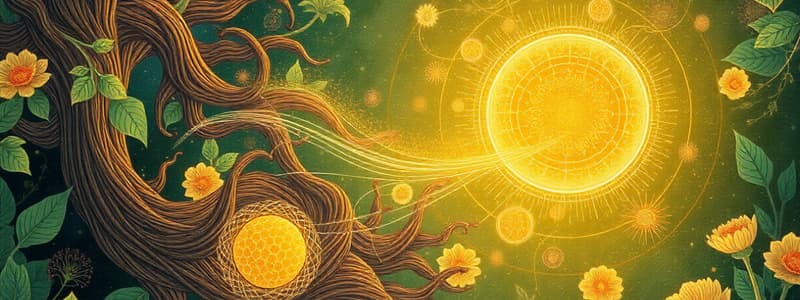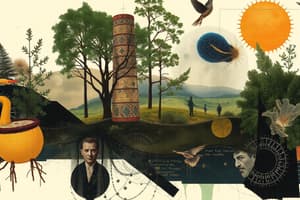Podcast
Questions and Answers
The main control center of a cell is the ______.
The main control center of a cell is the ______.
nucleus
Plants use sunlight to perform ______, creating food in the form of glucose.
Plants use sunlight to perform ______, creating food in the form of glucose.
photosynthesis
The process by which organisms are categorized based on similarities is known as ______.
The process by which organisms are categorized based on similarities is known as ______.
classification
A process that involves the breakdown of food into nutrients is called ______.
A process that involves the breakdown of food into nutrients is called ______.
In ecosystems, energy flows from the sun to ______, then to animals and decomposers.
In ecosystems, energy flows from the sun to ______, then to animals and decomposers.
Natural selection is often summarized as 'survival of the ______.'
Natural selection is often summarized as 'survival of the ______.'
Osmosis is a process that describes the movement of ______ in and out of cells.
Osmosis is a process that describes the movement of ______ in and out of cells.
One major human impact on the environment is ______, which affects air and water quality.
One major human impact on the environment is ______, which affects air and water quality.
Flashcards
Cells
Cells
The basic building blocks of all living things. They are like tiny factories, carrying out life processes.
Ecosystems
Ecosystems
All the living things in a specific area, along with their non-living environment.
Photosynthesis
Photosynthesis
The process by which plants use sunlight to make their own food (sugar).
Digestion
Digestion
Signup and view all the flashcards
Evolution
Evolution
Signup and view all the flashcards
Genetics
Genetics
Signup and view all the flashcards
Pathogens
Pathogens
Signup and view all the flashcards
Human Impact on Environment
Human Impact on Environment
Signup and view all the flashcards
Study Notes
Cells
- Cells are the basic building blocks of life.
- Parts of a cell include the nucleus (controls the cell), mitochondria (produces energy), and ribosomes (create proteins).
- Body organization progresses from cells to tissues, then organs, and finally systems (e.g., heart is part of circulatory system).
- Vaccines protect against diseases.
Organisms
- Habitats are the places where organisms live.
- Ecosystems involve communities of organisms interacting together.
- Energy flows from the sun to plants, then animals, and finally decomposers.
- Nutrient cycles, like the carbon cycle, involve plants taking in carbon dioxide and animals releasing it.
- Organisms are grouped by similarities, for example, mammals and reptiles.
Processes
- Photosynthesis is the process where plants use sunlight to create food (glucose).
- Respiration is the process of releasing energy. Aerobic respiration requires oxygen, while anaerobic respiration does not.
Metabolism
- Digestion breaks down food into nutrients.
- Transport involves moving substances into and out of cells, such as water movement through osmosis.
Evolution
- Natural selection is the "survival of the fittest."
- Genetics involves DNA determining traits passed from parents to offspring.
- Cell division includes mitosis (growth and repair) and meiosis (creation of sperm and egg cells).
Environment Interactions
- Plants grow towards light (tropism).
- Senses (eyes, ears, skin) help detect the environment.
- Hormones regulate growth and energy use.
Interactions Between Organisms
- Pathogens are disease-causing germs.
- Predators and prey show the relationships in ecosystems.
- Food chains illustrate who eats whom.
- Competition occurs for resources like food and space.
- Extinction occurs when a species cannot adapt to changes.
Humans and the Environment
- Human activities can negatively impact the environment.
- Conservation involves protecting nature.
- Solutions include recycling, clean energy, and waste reduction.
- Homeostasis maintains a stable internal body temperature and other conditions.
Studying That Suits You
Use AI to generate personalized quizzes and flashcards to suit your learning preferences.




